► Tecnica vs GT3
► How analogue can the Huracan get
► Porsche’s hardcore 911 a fierce benchmarkk
These cars are not direct rivals. The small matter of four cylinders, an entire market segment and some £76k separates Lamborghini Huracan Tecnica from Porsche’s 911 GT3 (or £122k with our ‘as tested’ options). What they share is philosophy and timing – driver engagement like it’s been concentrated through a magnifying glass, visceral thrills accented towards the track but accessible on the road, and the knowledge we have only a limited window in which to enjoy analogue cars like these, at least as new.
Naturally aspirated engines shared largely unchanged from GT3 racers are key to this urgency. Four litres in the Porsche, 5.2 in the Lambo, they rev like circular saws and do their best work when most newer, cleaner turbo engines are clocking off – you have to monster them to unlock their full potential.
Want to access more amazing content from CAR? Become a member of CAR here with a 99p trial!
Feel the noise: Huracan Tecnica vs 911 GT3
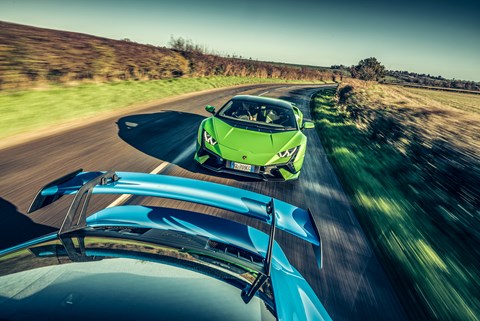
I’m in the Lamborghini first, following Jake Groves in the 911 GT3 as he drops two gears for a tight corner, paddleshift clicks unleashing two angry barks as the flat-six’s revs flick up. A raspish gasp of induction fills the vacuum of V10 noise when I follow suit in the Huracan, rolling into the corner hard before we both pin the throttle fractions of a second apart. The GT3 digs in and the Huracan locks onto its fat rump like there’s a gunsight in the centre of its fast-raked windscreen.
More than speed, it’s the sound and build to peak power that defines these experiences – both cars amass revs and sonics with a long, frenzied fury up through the gears – the serrated wail and pompy brass of the V10 dominates the Huracan’s cabin but the GT3’s flat-six is a howling blare up ahead, low in the mix if ever-present, like I’m playing the root note and Jake’s riffing further up the scale. Primal noise swirls like surround-sound.
The £212k Lamborghini is both newbie-on-test and the penultimate Huracan before Sant’Agata signs off production with the jacked-up Sterrato. Slotting between the rear-drive Huracan Evo and motorsport-derived STO, the Tecnica logically dials up the intensity, spec and feel of the former without getting as rowdy, uncompromising or pricey as the exceptional latter. (The 911 GT3 mirrors this positioning, sitting above a Carrera GTS and below the resolutely track-focused GT3 RS.) Want to road trip and trackday? Tecnica’s the ticket.
Its naturally aspirated V10 is borrowed from the Huracan STO with 631bhp at 8000rpm, all of it flowing to 305-section rear 20-inch tyres through a seven-speed dual-clutch gearbox. Carbon-ceramic brakes are standard, a revised suspension set-up features adaptive dampers, there’s 35 per cent more rear downforce than an Evo (if nowhere near the reinvention of the carbon-clad STO) and the Lambo is rear-wheel drive and rear-wheel steer only. At 1379kg dry, a Tecnica is only 40kg heavier than an STO, so acceleratively they’re close.
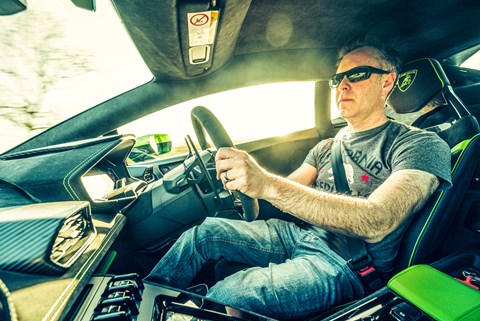
For all its barely concealed aggression, the Huracan Tecnica is surprisingly – and pleasingly – docile in ease-you-in Strada mode. Around town you feel each corner of the car reacting a little lumpily to bumps but moderate speed introduces elasticity to a set-up that’s tautly controlled and flows beautifully – note how healthy this ride height is for a supercar – and is really quite mellow over B-roads with awkward negative cambers and crowns.
Variable-ratio steering is similarly nuanced and delicate. There’s a little slack at the dead-ahead to dial out excess sensitivity, but weight and context beyond that. Once you’ve tipped it in, it brims with feedback, sparky response and natural self-centring forces.
Rear-wheel steering blends seamlessly with the dynamics, as Jake sums up: ‘It doesn’t feel as unnatural or augmented like it can in other cars – it’s still fluid.’ Switching to Sport mode tweaks the system’s reactivity so it arcs into oversteer more readily off-throttle, but the organic dynamic persists.
Even the noise of the V10 is very much a bit part below 4000rpm, where dual-clutch gearchanges slot smoothly. While there is road noise, it’s acceptable given the level of tactility streaming up through optional Bridgestone Potenza Race tyres (though with near-slick outer shoulders, they’re a liability in this morning’s 6ºC damp).
Shame the brakes wake so promptly but offer little modulation beyond their initial bite. ‘Brakes are insanely sharp,’ nods Jake. ‘So much as look at the pedal and you almost headbutt the steering wheel.’
Our only other dynamic negative relates to damper firmness being tied to pre-determined Strada/Sport/Race drive modes – a pity, given that Sport brings more STO spice to the surface with a fire-and-brimstone powertrain calibration but comes bundled with a significant drop in ride quality. ‘Borders on unbearable on the road unless it’s a silky-smooth surface,’ notes Jake.
Nonetheless, after just a few miles behind the wheel you know this is a properly sorted, engaging and usable Lambo, even if it did just smear through a third-gear corner with all systems engaged. Yikes.
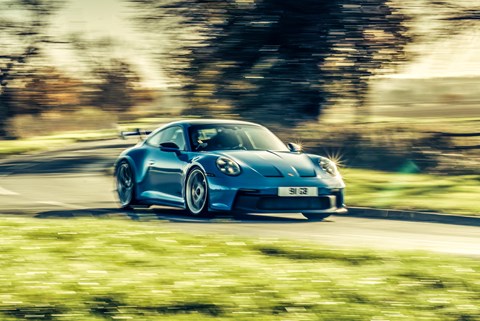
The 911 GT3 is happier in these conditions on its still highly aggressive Cup 2 tyres. You’ll probably know the GT3 by now – a roadgoing 911 inspired by Porsche’s motorsport exploits, winner of our 2021 Sports Car Giant Test against pricier rivals, darling benchmark of road testers. So it’s good. A big step over the Carrera range, it gets double-wishbone front suspension (not the MacPherson struts used on other 911s), 50 per cent more downforce than its predecessor and a 4.0-litre flat-six shared almost unchanged with the GT3 Cup racer. It weighs 1435kg with fluids.
Prices officially start from £135,700. But… join the queue.
I love the usability of the GT3. Mostly it’s architectural stuff like a more upright windscreen for better visibility and a perfect driving position that drops you low with legs straight ahead (our car gets optional and sublime 918 Spyder buckets) but it’s also in simple details – having indicator stalks rather than the Huracan’s steering-wheel buttons, window switches on door casings rather than toggle switches on the centre console.
As Jake points out, ‘The Lambo definitely has that Audi veneer of feeling well put together but button placement is mad, the portrait touchscreen is fiddly and I still don’t like the steering-wheel controls. A 911 is way more intuitive.’
The Porsche has road noise like surfing a 50-foot wave, though – way worse than the Huracan. That’s the price you pay for huge 315-section rear tyres (bigger than the Italian), a ball-jointed chassis for maximum precision and reduced soundproofing, all of which help make the GT3 such an event to drive.
The last GT3 I tested over these roads was a wing-free Touring with the manual gearbox, P Zero Corsas and standard brakes (it’s the nicer aesthetic IMHO). This one gets the PDK dual-clutch auto, Michelin Cup 2s and carbon-ceramic brakes, and immediately exudes a different attitude. The PDK is a little clumsier at parking speeds (though at least you get a physical gearlever to push over to manual, unlike the Carrera), the brake pedal doesn’t bite as crisply and this GT3’s steering – full of precision and gorgeously weighted as it is – is more sensitive and sniffier over cambers. Perhaps stiffer tyre shoulders and sidewalls are the reason, perhaps a difference in this car’s geometry settings, but the Touring was calmer.
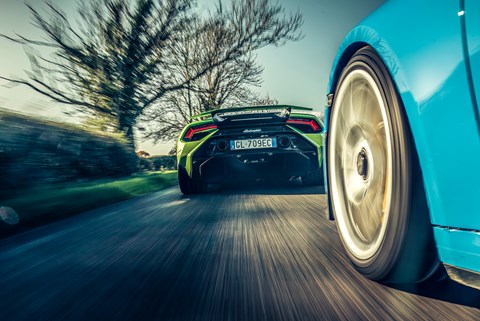
It rides well for such a focused machine, though – ‘only as firm in its firmest setting as the Huracan in Strada,’ thinks Jake – and there’s a kind of circuit-board-like stiffness coursing through this platform, like each wheel is a receiver and you’re the CPU plugged in the middle, mainlining high-fidelity data.
Plus… What. An. Engine. GT3 models now stand alone among 911s in shunning forced induction, and this 4.0-litre flat-six cranks with a gruff industrial chunter but morphs into a delicious howl (despite gasoline particulate filters that are usually the foe of decent sound). It offers an astonishing purity of response and rewards graft with a bandwidth stretching sky high to 9000rpm – so high you have to really steel yourself to hit that target.
A whisker over 500bhp and 347lb ft sounds a little flat on paper in these power-hungry times (fractions more than the last GT3, plus a Carrera S has a chunk more torque), but in reality it’s all-consuming performance that leaves you wondering why anyone needs extra.
Jake notes long-legged gearing knocks some of wind from the Porsche’s sails when you’re not driving like your hair’s on fire, but keep it lit past 4000rpm and this engine’s bandwidth and absolute clarity of response are spellbinding. ‘The Lambo pulls better during low-rev/high-gear acceleration but the GT3 still screams and surges forwards with insane power – and what a gorgeous noise,’ he comments.
The six-speed manual adds another layer of authenticity to the GT3 experience – beautiful tight action, nicely weighted clutch, perfect pedals for heel-and-toe – but equally our PDK syncs perfectly with the fizziness of this powertrain, popping in shifts like you’re flat-chat down the Mulsanne in an RSR.
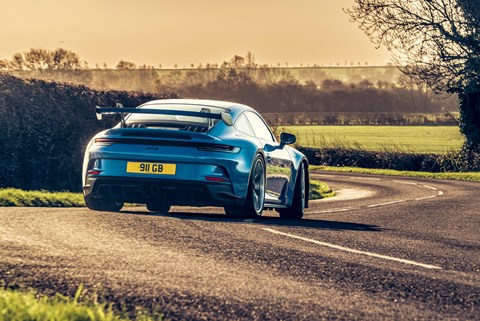
Besides, the real magic lies in how harmoniously this powertrain is integrated with steering, chassis, braking, the lot. Pretty wondrous stuff has been worked here, but a 992 GT3 is still very much a 911 – the nose is light and reactive, stability under heavier braking is exceptional (the rear engine prevents too much unstable weight transfer over the nose) and there’s monster traction to catapult you from turns.
It’s just that all those traits are purified and dialled right up – I get the smallest push of understeer only when the tyres are cold but otherwise it just bites unless you’re hellbent on clumsiness, so you can fire a GT3 into a corner knowing it’ll feel almost as planted loaded up as it does in a straight line, then climb all over the throttle early, confident the chassis can soak up all that power. Rear-wheel steering is mixed in there but it’s oh so subtle.
Add it together with relatively modest power and this is a momentum car that oozes mechanical grit and balance, encouraging you to shake every drop of BHP sauce from the bottle rather than squeeze it cautiously. Find the limits and again the Cup 2 tyres (and perhaps the electronic limited-slip differential versus the manual’s mechanical locker) make a pronounced difference versus the P Zero Corsas – it’s more of a slick-tyre feel with higher mechanical grip and an edgier transition to losing purchase. They’d probably be my track choice, but the more progressive Corsas strike a sweeter balance for road driving.
The roads have mostly lost their greasy sheen when I jump back into the Huracan, heading cross-country towards Silverstone for a few laps before handing the keys back to Lamborghini. Heat in the tyres and the balance is all response and chunky bite at the front, giving me confidence to carve into corners hard, loading up the front while the V10 starts to tweak the rear end round. Go with the flow and the tyres smear a few degrees over the surface like chewing gum – it’s simultaneously secure and adjustable.
What a contrast to the original all-wheel-drive Huracans, which would bite and grab more manically at the surface, steer nowhere near as delicately and were more complex to read dynamically. The Tecnica is so limber and relaxed in comparison, even driven hard.
Under-square versus the big-bore/shorter-stroke GT3, the Lamborghini V10 lacks 500rpm on the GT3 but it’s way more potent, unbelievably vital and startlingly responsive in the upper third of its rev range. Out of a roundabout, straight road ahead, it’s so rabid at high revs that I grit my teeth in second and third gear past 6500rpm, half expecting the tyres to be overwhelmed in what remain chilly conditions – thankfully Strada mode takes the sting out of that, blending performance with grip so expertly you easily forget that electronics are helping at all.
When I uncork all 8500rpm on Silverstone in all-out Corsa mode, the V10’s pure fire, wavering on the high notes like some glass-shattering operatic euphoria. The circuit’s damp and not really suited to the Race tyres, but that gorgeously malleable balance comes to the fore here, letting me feel out the grip with a little entry understeer, then squeezing on the power to cancel it out again, the tyres and revs flicking up like helium. It’s like I’m skating just a few millimetres over the surface but still working against the available grip – lovely, at least when there’s airfield-spec run-off… Even those over-sensitive brakes fade to the background when I’m digging deeper into the pedal travel. I’m out there lapping for half an hour on my own in absolute heaven.
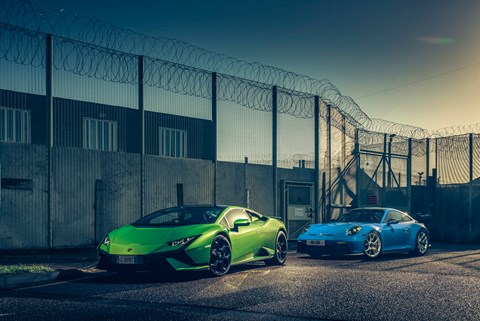
What a day. Two very different performance cars from Lamborghini and Porsche; two unbelievably intense experiences, and a fittingly celebratory climax as we reach the swansong of natural aspiration.
Let’s not kid ourselves and get too misty-eyed here – I won’t tell you that all the new turbo-hybrid cars pale in comparison to the 911 GT3 and Huracan Tecnica, because there’s some properly exciting kit coming through right now. But these cars are a reminder that – for all today’s mind-boggling progress – we are leaving something uniquely involving, analogue and raw behind.
Never mind miss them once they’re gone, better get out there and enjoy them while we still can, I reckon.